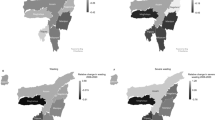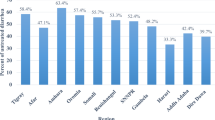Abstract
Objective:
This study aimed to evaluate the association of diarrhea and acute lower respiratory tract infections (ALRI) with growth of preschool children.
Design:
A longitudinal community-based study over a 12-month period. Children were followed up with thrice-weekly household visits for collection of morbidity data. Every 4 months (round) clinical and anthropometric examinations were performed. At baseline a questionnaire was used to collect socioeconomic family data and environmental household variables. Generalized estimating equation was used in the statistical analysis. The variations in weight-for-age or height-for-age Z-scores in each round were the dependent variables, while the main independent variables were the number of days with diarrhea and ALRI.
Setting:
Serrinha, located in Northeast Brazil.
Subjects:
In total, 487 children, aged 6–48 months at baseline, with 1-y complete follow-up.
Results:
The number of sick days with diarrhea or ALRI was not associated with mean changes in weight-for-age Z-scores. However, the mean of height-for-age Z-scores was found to decrease in those children with 7 or more days of diarrhea (β=−0.0472; P=0.016) but not with 1 or more days of ALRI (β=0.0022; P=0.406) in all rounds of the follow-up period.
Conclusion:
Results of the study reinforce the concept of diarrhea burden as a major determinant of poor growth in children under 5 y of age. Actions targeted to decrease the risk factors for the occurrence of diarrhea may represent an important component of interventions aimed to ensure satisfactory child growth.
Sponsorship:
Financial support was provided by the World Health Organization (CDD), PRONEX/CNPq/MCT of the Brazilian Government (Agreement no. 661086/1998-4) and UNICEF (NY).
This is a preview of subscription content, access via your institution
Access options
Subscribe to this journal
Receive 12 print issues and online access
$259.00 per year
only $21.58 per issue
Buy this article
- Purchase on Springer Link
- Instant access to full article PDF
Prices may be subject to local taxes which are calculated during checkout
Similar content being viewed by others
References
Administrative Committee on Coordination/Sub Committee on Nutrition News - United Nations (ACC/SCN) (2000): Nutrition through out the life cycle 4th edn Report on the World Nutrition Situation, Geneva.
Administrative Committee on Coordination/Sub Committee on Nutrition News—United Nations (ACC/SCN) (2001): What works? A review of efficacy and effectiveness of nutrition interventions. Geneva.
Allen LH & Uauy R (1994): Guidelines for the study of mechanisms involved in the prevention or reversal of linear growth retardation in developing countries. Eur. J. Clin. Nutr. 48 (Suppl 1), S12–S16.
Ariffen SE, Black RE, Caulfield LE, Antelman G & Baqui AH (2001): Determinants of infant growth in the slums of Dhaka: size and maturity at birth, breastfeeding and morbidity. Eur. J. Clin. Nutr. 55, 167–178.
Assis AMO, Santos LMP, Martins MC, Araújo MPN, Amorin DQ, Morris SS & Barreto (1997): Distribuição da anemia em pré-escolares do semi-árido da Bahia. Cad. Saúde Pública 13, 237–243. (in portuguese).
Associação Brasileira de Anunciantes (ANEP)/Associação Nacional de Empresas de Pesquisa (ABiPEME)—Critério de Classificação Econômica Brasil (1997): http://www.anep.org.br/codigosguias/CCEB.pdfAccessed on 22 July 2003.
Barreto ML, Santos LMP, Assis AMO, Araújo MPN, Forenzena GG, Santos PAB & Fiaccone R (1994): Effect of vitamin A supplementation on diarrhoea and acute lower-respiratory-tract infections in young children in Brazil. Lancet 344, 228–231.
BEMFAM/PNDS (1996): Sociedade Civil de Bem Estar Familiar no Brasil. Pesquisa Nacional sobre Demografia e Saúde (PNDS). Brasília (in portuguese).
Black RE, Moris SS & Bryce J (2003): Where and why are 10 million children dying every year? Lancet 361, 2226–2234.
Brasil. Ministério da Saúde (1990): Pesquisa Nacional sobre Saúde e Nutrição. Instituto Nacional de Alimentação e Nutrição, Brasília (in portuguese).
Briend A (1990): Is diarrhoea a major cause of malnutrition among the under-fives in developing countries? A review of available evidence. Eur. J. Clin. Nutr. 44, 611–628.
Brown KH, Black RE & Becker S (1982): Seasonal changes in nutritional status and the prevalence of malnutrition in a longitudinal study of young children in rural Bangladesh. Am. J. Clin. Nutr. 36, 303–313.
Brown KH (2003): Diarrhea and malnutrition. J. Nutr. 133 (Suppl 1), 328S–332S.
Checkley W, Epstein LD, Gilman RH, Cabrera L & Black RE (2003): Effects of acute diarrhea on linear growth in Peruvian children. Am. J. Epidemiol. 157, 166–175.
Checkley W, Gilman RH, Black RE, Epstein LD, Cabrera L & Sterling CR (2004): Effect of water and sanitation on childhood health in a poor Peruvian peri-urban community. Lancet 363, 112–118.
Duarte EC, Scchneider MC, Paes-Sousa R, Ramalho WM, Sardinha LMV, Silva Júnior JB & Castillo-Salgado C (2002): Epidemiologia das desigualdades em saúde no Brasil. Um estudo exploratório. FUNASA/OPAS/OMS. Available at http://www.funasa.gov.Br/pub/epi_desigualdades/epi_desigualdades.pdfAccessed on 22 July 2003.
Guerrant RL, Kirchhoffk LV, Shields DS, Nations MK, Leslie J, Sousa MA, Araujo JG, Correia LL, Sauer KT, McClelland KE, Trowbridge FL & Hughes JM (1983): Prospective study of diarrheal illnesses in Northeast Brazil: Patterns of diasease, nutritional impact, etiologies and risk factors. J. Inf. Dis. 148, 986–997.
Habicht JP, Martorell R, Yarbrough C, Malina RM & Klein RE (1974): Height and weight standards for preschool children: how relevant are ethnic differences in growth potential. Lancet 1, 611–614.
Hosmer DW & Lemeshow S (1989): Applied Logistic Regression. A Wiley-Interscience Publication, New York: Jonh Wiley & Sons.
Kosek M, Bern C & Guerrant R (2003): The global burden of diarrheal disease, as estimated from studies published between 1992 and 2000. Bull. World Health Org. 81, 197–204.
Liang KY & Zeger SL (1986): Longitudinal data analysis using generalized linear models. Biometrics. 73, 13–22.
Lima AAM, Moore SR, Barboza MS, Soares AM, Schleupner MA, Newman RD, Sears AM, Nataro JP, Fedorko DP, Wuhib T, Schorling JB & Guerrant RL (2000): Persistent diarrhea signals a critical period of increased diarrhea burdens and nutritional shortfalls: a prospective cohort study among children in Northeastern Brazil. J. Infect. Dis. 81, 1643–1651.
Lohman TG, Roche AF & Martorell R (1988): Anthropometric Standardization Reference Manual. Illinois: Human Kinetics Books.
Lunn PG, Northrop-Clewes CA & Downes RM (1991): Intestinal permeability, mucosal injury, and growth faltering in Gambian infants. Lancet 338, 907–910.
Morris SS, Cousens SN, Kirkwood BR, Arthur P & Ross DA (1996): Is prevalence of diarrhea a better predictor of subsequent mortality and weight gain than diarrhea incidence? Am. J. Epidemiol. 144, 582–588.
Moy RJD, Marshall TFC, Choto RGA & McNeish AS (1994): Diarrhoea and growth faltering in rural Zimbabwe. Eur. J. Clin. Nutr. 48, 810–821.
National Center for Health Statistics-NCHS (1997): Growth curves for children birth-18 years. Department of Health, Education and Welfare (Vital and Health Statistics, series 11). United States. Washington.
Rowland MGM, Rowland SGJG & Cole TJ (1988): Impact of infection on the growth children from of 0 to 2 years in an urban west African community. Am. J. Clin. Nutr. 47, 134–138.
Santos LMP, Assis AMO, Martins MC, Araújo MPN, Morris SM & Barreto ML (1996): Situação Alimentar e Nutricional de Pré-Escolares no Semi-Árido da Bahia: II Hipovitaminose A. Rev. de Saúde Pública. 30, 67–74. (in portuguese).
SAS (1999-2000): System for Windows V8. Cary, USA: SAS Institute Inc.
Schorling JB, McAuliffe JF, De Souza MA & Guerrant RL (1990): Malnutrition is associated with increased diarrhea incidence and duration among children in an urban Brazilian slum. Int. J. Epidemiol. 19, 728–735.
Scrimshaw NS (2003): Historical concepts of interactions, synergism and antagonism between nutrition and infection. J. Nutr. 133 (Suppl 1), 316S–321S.
Stephensen CB (1999): Burden of infection on growth failure. J. Nutr. 129 (Suppl 2), S534–S538.
Valentiner-Branth P, Steinsland H, Santos G, Perch M, Begtrup K, Bhan MK, Dias F, Aaby P, Sommerfelt H & Molbak K (2001): Community-based controlled trial of dietary management of children with persistent diarrhea: sustained beneficial effect on ponderal and linear growth. Am. J. Clin. Nutr. 73, 968–974.
VanDerslice J & Biscoe J (1995): Environmental interventions in developing countries: Interactions and their implications. Am. J. Epidemiol. 141, 135–144.
Victora CG, Barros FC, Kirkwood BR & Vaughan P (1990): Pneumonia, diarrhea, and growth in the first 4 y of life: a longitudinal study of 5914 urban Brazilian children. Am. J. Clin. Nutr. 52, 391–396.
Villamor E, Mbise R, Spiegelman D, Hertzmark E, Fataki M, Peterson KE, Ndossi G & Fawzi WW (2002) Vitamin A supplements ameliorate the adverse effect of HIV-1, malaria and diarrheal infections on child growthhttp://www.pediatrocs.org/cgi/content/full/109/1/e6Accessed on 22 October 2004.
Waldman EA, Barata RCB, Moares JC, Guibu IA & Timenetsky ST (1997): Gastroenterites e infecções respiratórias agudas em crianças menores de 5 anos em área das região Sudeste do Brasil, 1986–1987. II-Diarréias. Rev. Saúde Pública 31, 62–70. (in portuguese).
Waterlow JC (1992): Protein Energy Malnutrition. A Division of Hodder & Stoughton. London, Melbourne, Auckland, London, England: Edward Arnold. p. 407.
WHO (1995): Physical Status: The Use and Interpretation of Anthropometry. Geneva: WHO.
WHO (2000): Management of the Child with a Serious Infection or Severe Malnutrition. Guidelines for Care at the First-referral Level in Developing Countries. Geneve: WHO.
Zeitlin M, Ghassemi H & Mansour M (1990): Positive deviance in Child Nutrition. Tokyo: The United Nations University.
Author information
Authors and Affiliations
Corresponding author
Additional information
Guarantors: ML Barreto and LMP Santos.
Contributors: R Fiaccone and GSS Gomes.
Rights and permissions
About this article
Cite this article
Assis, A., Barreto, M., Santos, L. et al. Growth faltering in childhood related to diarrhea: a longitudinal community based study. Eur J Clin Nutr 59, 1317–1323 (2005). https://doi.org/10.1038/sj.ejcn.1602245
Received:
Revised:
Accepted:
Published:
Issue Date:
DOI: https://doi.org/10.1038/sj.ejcn.1602245
Keywords
This article is cited by
-
Associations between Shared Sanitation, Stunting and Diarrhoea in Low-Income, High Density Urban Neighbourhoods of Maputo, Mozambique - a Cross-Sectional Study
Maternal and Child Health Journal (2024)
-
Intestinal helminth infections and dietary diversity score predict nutritional status of urban schoolchildren from southern Ethiopia
BMC Nutrition (2017)
-
Determinants of undernutrition among children aged 6 to 59 months in rural Zambézia Province, Mozambique: results of two population-based serial cross-sectional surveys
BMC Nutrition (2015)
-
Comparison of impact and cost-effectiveness of rotavirus supplementary and routine immunization in a complex humanitarian emergency, Somali case study
Conflict and Health (2015)
-
Undernutrition among HIV-positive children in Dar es Salaam, Tanzania: antiretroviral therapy alone is not enough
BMC Public Health (2011)



